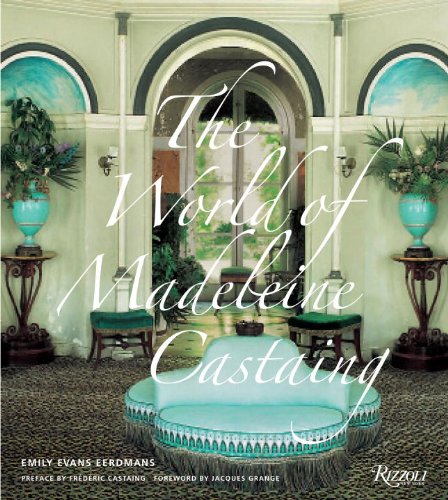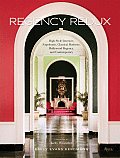
Editor's note: Not that Magnaverde needs any introduction, but it's impossible to resist saying a few words about the man who introduced me to Rue Winterbotham Carpenter and the most drop-dead glam interiors I have ever laid eyes on at Chicago's Casino Club. A comment from Magnaverde is something every blogger looks forward to - and many readers as well as he currently ranks in my top 10 search terms of the year. (Keep guessing #1 for a free copy of RR)
When Emily asked me to contribute something to her anniversary week posts, I couldn’t tell her no. In fact, I said yes before I even had a clear idea of exactly what the topic was supposed to be—Inspiring Interiors or Influential Interiors, something like that--but hey, that’s never stopped me before.
Anyway, if it was “Influential Interiors”, I can think of a slew of them: a large, high, lustrous-walled yellow salon in overcast London; a tiny brown-lacquered jewelbox of a studio apartment high above Manhattan; a monochromatic parchment-covered room in France; a glittering black-&-white dining room in Lake Forest, all of which have influenced several generations of later designers—but why talk about rooms that many Fans of Emily could describe better, especially considering that, unlike me, many of those people have probably seen said rooms in person, and know, (or have known) some of those rooms’ creators? So I’ll leave that subject to those who know what they’re talking about.
And I can hardly talk about rooms that have inspired my own work, since there’s not much of that & what there is is pretty insignificant. A few weeks ago I went to a reception in the ultra-glamorous Chicago penthouse that David Adler did for the Charles Goodspeeds in 1927,
and the very first person to greet me when I walked in the door was Joe Nye. Now, I’ve always been a fan of David Adler, and after seeing Joe’s wonderful apartment in last summer’s House Beautiful, I instantly became a huge fan of his, too, but I can’t imagine either of them being particularly thrilled to know that they’ve ‘inspired’ me.
Basically, they inspire me in the same way that, say, an opera singer inspires the person humming along with the aria in row seven. The impulse toward beauty is inborn & the instinct to copy is innate, but sometimes, seeing (or hearing) the mediocre results, you wish they weren’t. So I’m not going to try to invite comparisons with the work of others by saying that ‘So-&-so has inspired me’. It would only embarrass everyone.
So I’ll avoid the potential pitfalls of those two excellent topics and simply say that the interior that made the single biggest impact on me was one I never saw in person. It ceased to exist a decade before I was born, and by the time I first saw a black-&- white photo of it when I was twelve, its creator had been dead for more than twenty years. Back then, that was a lifetime.
These days, of course, we have the Internet, and blogs, which act on printed history the way the ocean currents act on the sea floor, constantly casting up flotsam from the cold, dark depths of the sea onto the densely populated beach. Sometimes, it’s nothing, sometimes, in among the sea-wrack, you spot a gem. Other times, you looking away for just a moment & turn back just as the undertow grabs the gem & sends it straight back to the bottom. Like Ferris Bueller says, if you don’t keep your eyes open, you could miss it.
So, why, even in the days of the Internet and Google searches, is the name of William Odom so little known? Sure, he’s in Wikipedia & in the footnotes in all the design history books (if you know to look him up in the first place - Editor's Note: Erica Brown's book on the storied firm McMillen is a good place to start)—but, basically, he’s the Millard Fillmore of Interior Design: just another name in a list of names. To most people--even to most designers--his name means absolutely nothing. For me, though, Odom opened up a view of a different world, one unlike anything I ever saw in Danville, Illinois, or in Clinton, where we lived next. My dad was the head of the Chamber of Commerce, so we knew people with money, but none of their houses, not even the mansions of the town’s millionaires, looked anything like this. Then again, this room, Odom’s music room, was already thirty years old when I first saw it. It had a double-page spread in my mother’s copy of the 1947 edition of House & Garden’s Complete Guide to Interior Decoration.
The book was a wedding shower gift—it says so right in the faded inscription—so it must have been in our bookshelves for my whole childhood, but for some reason I never noticed it before that day in 1963. Who knows why I happened to pull it off the shelf that first day? But I did, and ever since, I’ve cared about the way houses look, and even more, how they ought to look. I was certainly the only kid on the seventh grade softball team that went home after practice to learn about pickled wood & Monel metal & moss fringe, all of which had been long out of fashion by the time I first heard the terms. But how would I know that? That’s the beauty & innocence of childhood. So I had no crippling fear of my newly-budding tastes being ridiculed as already dated or my new interest in such things being branded weird. Not, of course, that I made a point of telling my classmates what I was up to, either. In Clinton, Don’t Ask, Don’t Tell was standard operating procedure. After all, I had classmates whose families still made moonshine in the woods.
Anyway, that’s how it all started: me & a book & William Odom’s music room. Back then I loved the room because it seemed absolutely modern & white, 'modern', of course, being a relative term when you grow up in a house full of inherited black walnut furniture. Today, what impresses me is how Odom created that feel of crisp modern glamor--this could be a set for Jean Harlow movie--without using a stick of Modern furniture or resorting to any of the cliches of the period. There's no Marion Dorn rug on the floor, no chromium torcheres, no plaster palms on the walls. Instead, Odom used what could have been, in other hands, a dog's-dinner hodgepodge of period pieces: Louis XVI & Regency chairs, a Chinese Chippendale table, Venetian mirrors above unmatched console tables on either side of the fireplace, all of it topped off with a pair of spectacular bronze-&-marble Empire lamps in glossy paper shades. Yet the final result of all that is brilliantly Modern. Of course, an acre of plate glass mirror, plain white upholstery & gleaming white Venetian blinds to pull it all together didn't hurt. But the most remarkable thing about this room--and that thing that you don't notice at first glance--is that there's absolutely no art on the walls. But then, mere paintings would have been superfluous, because the whole room is a work of art. No wonder I was smitten at once with this thing called interior decoration. William Odom was my hero.
Of course, I know now that I’ll never, ever have a room as beautiful and serene as this, but I still haven’t given up hope of someday finding a pair of those Egyptian lamps. In the meantime, I have a pair of tall black-&-gold candlestick lamps of the same general size, with shades in the same shape holding down either end of a long sideboard in my apartment: they’re nothing special, but that’s ok, because they’re just place holders anyway, waiting until the real things show up. They're out there somewhere.
Around here, though, EEE’s the real thing. Congratulations on your first year, Emily. And thanks for inviting me to your party. I’m honored.










6 comments:
Magnaverde, a beautifully woven story. Do we all have that childhood moment? I hope so.I ran into Bobsy Godspeed when reading through some Gertrude Stein things-She is another post. Best of all an interior that evokes memory is important.Thanks for the memory. la
I also think it's a shame that Odom is not better known. But in addition to the recognition for his great style, he should also be remembered for the role he played in establishing Parsons' Paris outpost. After all, it was at Parsons Paris where Odom taught and influenced a young Van Day Truex. I also think he was from Georgia.
You Magnaverde are not a place holder waiting for the real thing. Some times we are born to greatness and sometimes greatness finds us. I think your greatness is in the sighing, musing and writing of places that haunt or taking them to task when they don't. Do take care. And as I have noted before, when you have a cold coming on, make sure potatoes are on hand. The world of applied art is waiting. My husband came home from basketball practice, did his homework and went to sleep reading Yeats. Now he quotes Yeats to me at such delightful moments.
Emily - it's your birthday and here you are giving us presents. You're spot on that a comment from Magna can make my whole day. This is a treasure. You have to admire any man who can refer to Odom, Adler and Beuhler in the same post.
So tantalizingly obscure is William Odom at this point in time, it was a real treat to have Magnaverde's delightful tribute. It prompted a search among my own bookshelves for a few more images of Odom's apartment at the Pierre Hotel; and in the book Manhattan Style we notice that by the late 30s he replaced the Italian mirrors (flanking the mirrored chimney wall) with overscaled English flower paintings from the mid 19th century. The mood of modernity wasn't sacrificed in the least by this romantic gesture!
William Odom definitely had "it".
Somwhwere, there's a cache of David Payne room portraits just waiting to be made into a book, and somewhere in the stack is a painting of Odom's suite at the Pierre, at a slightly earlier period than this photo, with the same Chippendale table but with what seem to be Odom's own placeholder lamps for the later Empire lamps. The early stand-ins themselves are no slouches, either. They're also Egyptian figures--draped males, this time-- and if I remember correctly, their design comees from the supports on one of Thomas Hope's massive pier tables. I've never seen the female versions of these lamps in real life, but the male figures seem to be more common--if having seen two sets of them over the course of my entire life qualifies them as 'common'. All I know is there's a pair of them in the lobby of a 1920s apartmenet buiding on Lake Shore Drive, and I look through the windows at them every night on my way home.
Anyway, I don't have a copy of the original magazine that the David Payne painting of Odom's room was in, and the only later reproduction of it that I know about is in the big anniversary book that House & Garden put out in the 1980s, which was, unfortunately, one of the worst-produced books I've ever seen: rough paper, lifeless reproductions, & a general we're-only-doing-this-because-we-have-to vibe about the whole thing. The best part was the charcoal-&-gold dust jacket. Payne's distinctive paintings deserved better treament than they got with that book. Hell, we all deserved better.
Post a Comment